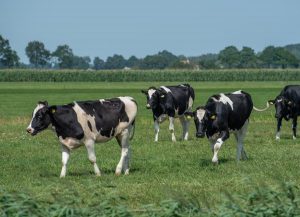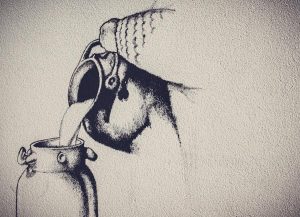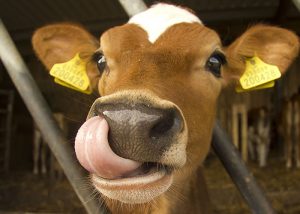Alvaro Garcia
Most colostrum is readily absorbed during the first hours of life, when the intestinal epithelium is still open to the passage of larger molecules (e.g., IgG, IgA, and IgM). Aside from its well-known effects on providing passive immunity through immunoglobulins, colostrum is an excellent source of nutrients with a much higher concentration compared with that of milk.
In addition, colostrum adds to what has been termed ‘metabolic programming’, which begins in-utero and continues after birth. Milk-borne bioactive factors transferred from the mother in early life, play a critical role in programming later life events through cellular signaling mechanisms, immunity, and growth and differentiation of the digestive tract.
Bioactive compounds present in colostrum include immunoglobulins, bioactive peptides (cytokines), lactoferrin, oligosaccharides, hormones, growth factors (insulin-like growth factor-I, epidermal growth factor, and transforming growth factor), and immune-related microRNA, which play critical roles in the health and development of the newborn calf.
Some constituents of the cow’s colostrum such as monocyte differentiation antigen CD14, xanthine dehydrogenase or oxidase, glycosylation-dependent cell adhesion molecule 1, lactadherin, and clusterin have been proposed as modulators of the immune system. As a result, increasing the duration of colostrum administration likely enhances the calf’s immunity, health, and performance later-on in life.
Other important aspects of colostrum feeding are the stimulation of development and maturation of the gastrointestinal tract, helping with the establishment of beneficial bacteria, intestinal enhanced glucose uptake, increased concentrations of plasma glucagon-like peptide-1, and an overall reduction of morbidity and mortality.
A recent study (Kargar et al. 2020) looked at the effects of extended colostrum feeding on growth performance and health by partially replacing pasteurized milk with pasteurized colostrum (0, 350, and 700 g/day) for two weeks. A total of 144 Holstein 2-day old heifer calves were weighed, housed in individual pens, and monitored daily for signs of disease, and assigned to the following treatments:
- 5 kg of pooled pasteurized whole milk without colostrum (C0)
- 0.350 kg of pooled pasteurized colostrum and 4.650 kg pasteurized whole milk (C350)
- 0.700 kg of pooled pasteurized colostrum and 4.300 kg of pasteurized whole milk (C700)
Calves were on these treatments for 14 days, and then fed 5 kg/day of pooled pasteurized (39.5 ± 0.5°C) whole milk daily until day 56; this was followed by a step-down decrease (1 kg/d) until weaning on day 61of age. Pasteurized whole milk (65°C for 30 min) and colostrum (60°C for 40 min) were mixed at ratios of 14:1 (C350) and 7:1 (C700) as treatment groups.
The quality of the pooled colostrum was determined daily with a refractometer. Daily colostrum (Brix value = 25 ± 1.24%, range: 22–28%) was pooled, pasteurized, and fed at 6.5% of birth weight at 1 and 12 hours after birth. From day two on, calves were allocated to their treatments and individually fed 2.5 kg of liquid feed in the morning and 2.5 kg in the evening. One day after the first feeding of colostrum, jugular blood samples were taken to determine serum total protein using a commercially available hand-held clinical refractometer.
The partial replacement of whole milk with colostrum increased liquid feed dry matter (DM) intake but decreased milk DM intake.
Overall, the C700 calves recorded greater weaning weight, final body weight, heart girth change, feed efficiency, and average daily gain (ADG). The calves that received only milk had higher chances of body temperatures above 39.4°C.
Overall colostrum feeding resulted in fewer days with diarrhea
Overall colostrum feeding resulted in fewer days with a rectal temperature above 39.4°C, diarrhea, and pneumonia. Diarrhea was more prevalent in C0 versus C700 calves, while the occurrence of pneumonia tended to be higher in calves fed only milk compared with C350 and C700 animals.
Compared with C350 the C700 treatment calves had greater final body weight with moderate effect on size. Moreover, there were positive although moderate effects of feeding colostrum (C700 vs. C0) on postweaning ADG and final body weight.
Results of this experiment showed that partially replacing milk with colostrum during the first 14 days of life improved weight gain in dairy calves that are fed only whole milk and had fewer days with diarrhea or pneumonia.
Reference
Extended colostrum feeding for 2 weeks improves growth performance and reduces the susceptibility to diarrhea and pneumonia in neonatal Holstein dairy calves. 2020. S. Kargar, M. Roshan, S. M. Ghoreishi, A. Akhlaghi, M. Kanani, A. R. Abedi Shams-Abadi, and M. H. Ghaffari. Dairy Sci. 103:8130–8142.
© 2020 Dairy Knowledge Center. All Rights Reserved.









